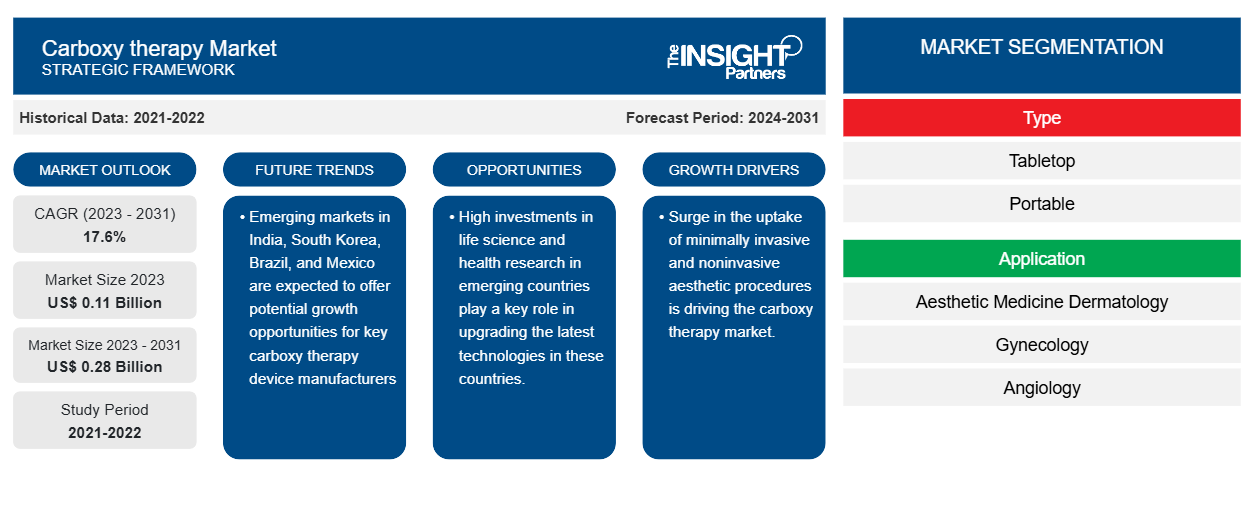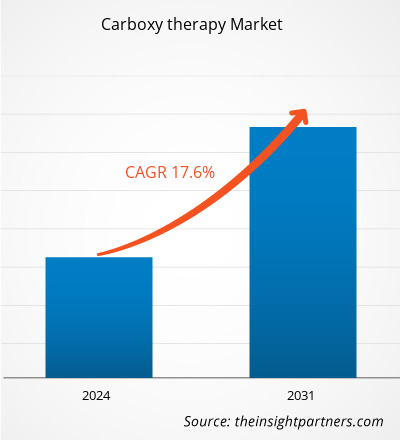The carboxy therapy market size is projected to reach US$ 0.28 billion by 2031 from US$ 0.11 billion in 2023. The market is expected to register a CAGR of 17.6% during 2023–2031. An increase in application areas will likely remain a key trend in the market.
Carboxy therapy Market Analysis
The market drivers include the growing adoption of non-invasive aesthetic procedures, increasing demand for antiaging treatments, and the surge in the geriatric population. Furthermore, the untapped potential of emerging economies is a crucial opportunity for the carboxy therapy market players.
Carboxyt herapy Market Overview
The World Health Organization (WHO) recognizes waste reduction in healthcare delivery as an essential aspect of strengthening healthcare systems. Technological advancements have led to the development of surgical approaches that minimize waste and achieve better results with available resources. Minimally invasive surgeries (MIS) and non-invasive procedures are among the approaches that result in low waste generation and reduced medical expenses. Moreover, these procedures ensure low absenteeism at the workplace, which has a net positive effect on the productivity of an economy. According to the International Society of Aesthetic Plastic Surgery, 14,400,347 million minimally invasive cosmetic procedures were performed globally in 2020. The use of these procedures rose by 22.7% during 2016-2020 on a global level, and they now account for ~59% of aesthetic interventions in the country.
Customize This Report To Suit Your Requirement
You will get customization on any report - free of charge - including parts of this report, or country-level analysis, Excel Data pack, as well as avail great offers and discounts for start-ups & universities
Carboxy therapy Market: Strategic Insights

-
Get Top Key Market Trends of this report.This FREE sample will include data analysis, ranging from market trends to estimates and forecasts.
Carboxy therapy Market Drivers and Opportunities
Increasing Demand for Antiaging Treatments Along With Surge in Geriatric Population
The elderly population in the world is anticipated to reach 1.4 billion in 2030, 2.1 billion in 2050, and more than 3.1 billion in 2100. The Global Ageing 2019 survey deduced that the world's population of people aged 65 and above totaled 703 million in 2019. The elderly population is expected to double to 1.5 billion by 2050. The frequency of people aged 65 or above is likely to increase from 1 in 11 to 1 in 6 from 2019 to 2025. According to the WHO, the percentage of people aged 60 and above is estimated to reach 22% by 2050 from 12% in 2015. The number of Americans aged 65 and above is estimated to increase from 46 million in 2016 to more than 98 million by 2060, and this demographic group will account for ~24% of the global population by 2060, up from 15% in 2016, states the US Census Bureau.
Untapped Potential of Emerging Economies
Carboxy therapy involves the use of carbon dioxide gas as injectables, and increasing application areas made it one of the most used treatment modalities in dermatology, aesthetic medicine, and anti-aging medicine. As the therapy started gaining traction in the past few years, significant developments have occurred in the devices used for the treatments. Conventional devices are in the form of pens, which are small in size but heavy in nature, which makes them difficult to hold during long sessions. This led to the development of devices that are sophisticated and easy to use. Additionally, increased innovations and technological advancements allow multiple puncture techniques for a distance of 1 cm for boluses.
Carboxy therapy Market Report Segmentation Analysis
Key segments that contributed to the derivation of the carboxy therapy market analysis are offerings, usage, and end users.
- Based on type, the carboxy therapy market is segmented into tabletop, portable, and others. The tabletop segment held the most significant market share in 2023.
- Based on application, the carboxy therapy market is bifurcated into aesthetic medicine cellulite, stretch marks, alopecia, and dark under-eye circles. The aesthetic medicine segment held the most significant market share in 2023.
- Based on end users, the carboxy therapy market is segmented by hospitals, aesthetic clinics, and wellness centers. The hospital's segment held the largest market share in 2023.
Carboxy therapy Market Share Analysis by Geography
The geographic scope of the carboxy therapy market report is mainly divided into five regions: North America, Asia Pacific, Europe, Middle East & Africa, and South & Central America.
In North America, the US carboxy therapy market holds the largest share of the region. The growth of the market in the country is defined by various factors, such as the rise in the development of non-invasive and minimally invasive procedures, which has exponentially increased the aesthetics procedures such as fat reduction and antiaging treatments. A study by the American Society of Plastic Surgeons 2020 states that 15.6 million cosmetic treatments were done in 2020, with 13.2 million cosmetic minimally invasive procedures and about 2.3 million cosmetic surgical operations. Additionally, the increasing application areas of carboxytherapy in medical fields such as neurology, gynecology, and urology are also expected to contribute significantly to the growth of the carboxy therapy market.
Carboxy therapy Market Regional Insights
The regional trends and factors influencing the Carboxy therapy Market throughout the forecast period have been thoroughly explained by the analysts at The Insight Partners. This section also discusses Carboxy therapy Market segments and geography across North America, Europe, Asia Pacific, Middle East and Africa, and South and Central America.
Carboxy therapy Market Report Scope
| Report Attribute | Details |
|---|---|
| Market size in 2023 | US$ 0.11 Billion |
| Market Size by 2031 | US$ 0.28 Billion |
| Global CAGR (2023 - 2031) | 17.6% |
| Historical Data | 2021-2022 |
| Forecast period | 2024-2031 |
| Segments Covered |
By Type
|
| Regions and Countries Covered |
North America
|
| Market leaders and key company profiles |
|
Carboxy therapy Market Players Density: Understanding Its Impact on Business Dynamics
The Carboxy therapy Market is growing rapidly, driven by increasing end-user demand due to factors such as evolving consumer preferences, technological advancements, and greater awareness of the product's benefits. As demand rises, businesses are expanding their offerings, innovating to meet consumer needs, and capitalizing on emerging trends, which further fuels market growth.

- Get the Carboxy therapy Market top key players overview
Carboxy therapy Market News and Recent Developments
The Carboxy therapy Market is evaluated by gathering qualitative and quantitative data post primary and secondary research, which includes important corporate publications, association data, and databases. A few of the developments in the carboxy therapy market are listed below:
- Cosmo Pro Ltd. launched the DIOX carboxy therapy system. The DIOX system features a touch-screen interface in both automatic and manual modes. (Source: Cosmo Pro Ltd, Inc., Company Website, January 2020)
Carboxy therapy Market Report Coverage and Deliverables
The “Carboxy therapy Market Size and Forecast (2021–2031)” report provides a detailed analysis of the market covering below areas:
- Carboxy therapy market size and forecast at global, regional, and country levels for all the key market segments covered under the scope
- Carboxy therapy market trends as well as market dynamics such as drivers, restraints, and key opportunities
- Detailed PEST/Porter’s Five Forces and SWOT analysis
- Carboxy therapy market analysis covering key market trends, global and regional framework, major players, regulations, and recent market developments.
- Industry landscape and competition analysis covering market concentration, heat map analysis, prominent players, and recent developments in the carboxy therapy market
- Detailed company profiles
Frequently Asked Questions
Which region dominated the carboxy therapy market in 2023?
What are the driving factors impacting the carboxy therapy market?
What are the future trends of the carboxy therapy market?
Which are the leading players operating in the carboxy therapy market?
What is the expected CAGR of the carboxy therapy market?
- Historical Analysis (2 Years), Base Year, Forecast (7 Years) with CAGR
- PEST and SWOT Analysis
- Market Size Value / Volume - Global, Regional, Country
- Industry and Competitive Landscape
- Excel Dataset
Recent Reports
Testimonials
Reason to Buy
- Informed Decision-Making
- Understanding Market Dynamics
- Competitive Analysis
- Identifying Emerging Markets
- Customer Insights
- Market Forecasts
- Risk Mitigation
- Boosting Operational Efficiency
- Strategic Planning
- Investment Justification
- Tracking Industry Innovations
- Aligning with Regulatory Trends





















 Get Free Sample For
Get Free Sample For